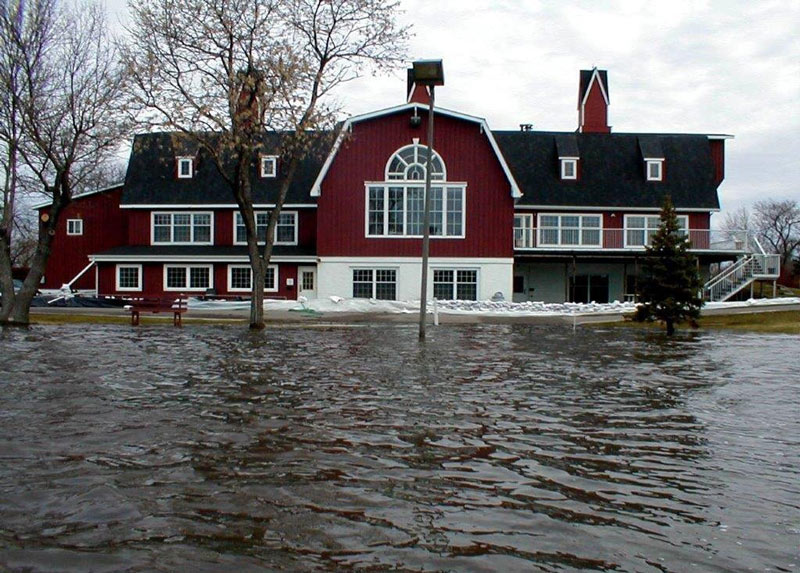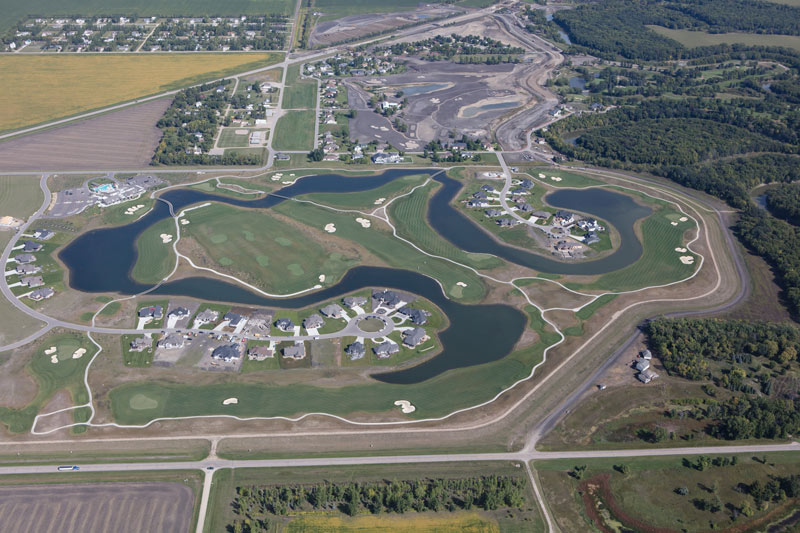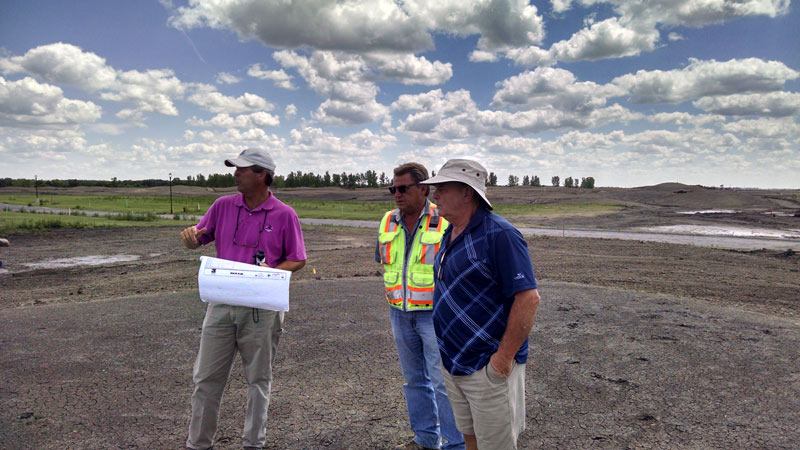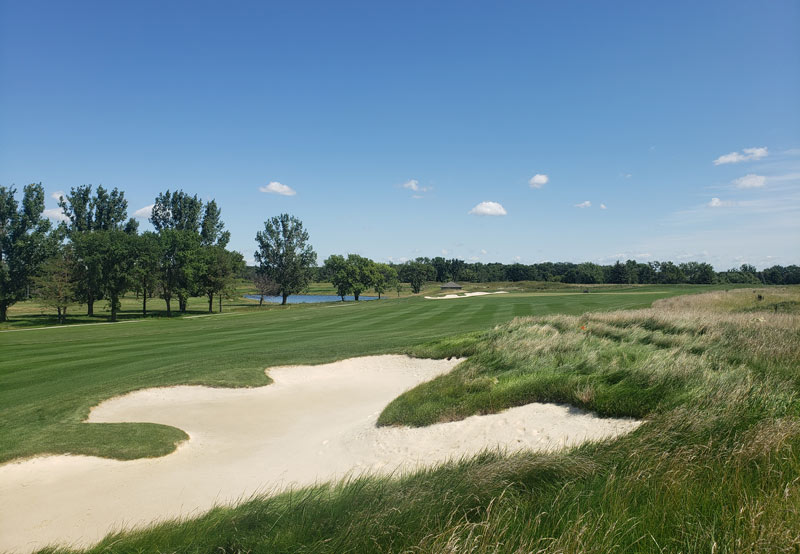
The old clubhouse at Oxbow (N.D.) Country Club, photographed from a boat afloat directly over the 18th green. Spring flooding was a regular, unavoidable occurrence at Oxbow before a larger, government-funded project to alleviate flooding in the area allowed the club’s membership to launch a drastic course renovation. Photos courtesy of David Wood
You’ll have to excuse David Wood, the GCSAA Class A superintendent at Oxbow (N.D.) Country Club. He’s not much on river views.
For years, members at this private club just south of Fargo bragged on those sights, as the Red River did in fact squiggle past their Robert Trent Jones II-designed course. But Wood never shared their enthusiasm. Spring flooding that would routinely submerge the pump house under 10 feet of river water will do that to a guy — to say nothing of the havoc such flooding would wreak on turf health or the layer of river silt that would blanket the entire routing after the waters finally subsided.
Now, a massive, just-completed renovation at the club, occasioned by the construction of a higher levee, would appear to have mooted all of those problems. Wood is not mourning the lost aesthetics.
“No one will ever play Oxbow and say there are beautiful river views out there,” the 29-year GCSAA member says. Again, if you’re fan of riverside golf, you’ll have to excuse Wood. “Unless you’ve had a golf course on a river that floods, I don’t know how else to explain it.”
The river giveth ...
Wood was raised across that river from the golf course, in southern Minnesota. He arrived in Oxbow from St. Cloud (Minn.) Country Club in 1995, and he remembers quickly falling in love with the course, the property, the modest levee (which allowed those views of the Red River) and the hundreds of ash trees that gave the 1975 Jones II design its distinctive parkland feel.
Within just a few years, however, things started to change.
“Before I got here, things had been dry, dry, dry for many years,” Wood recalls. “When they built the course, they thought the levee was big enough to protect it and all the homes behind it. But around 1997, we got into a wet cycle, and that cycle has not quit. I’ve been here 25 years and seen eight major floods. You can’t do anything about them. The levee stopped summer floods from hitting us, but the spring melt we couldn’t prevent.
“It’s just the nature of the beast here. They built this course on a beautiful piece of land, but the river flows north right here, hits the ice, backs up and breaches the levee. Then we’re in a giant bathtub, and you can’t take the water off the golf course until the river comes down.”
Is the change climate-related?
“I don’t know if it’s climate-related,” Wood says. “It’s a fair question. Being that we’re such an agricultural community, the flooding affects many people and the economy. This fall was very wet. Farmers are leaving crops in the field. Sugar beets, for example — they won’t take them after a freeze. With the amount of moisture we’ve been receiving, the drainage basin we’re in is the drainage basin we’re in. And the frequency of floods has increased. That is for sure.”
New levee offers a lifeline
In 2014, the membership at Oxbow saw an opportunity to address the situation and make lasting change when the Fargo-Moorhead Flood Diversion Authority secured state and federal funding to rebuild the levee at double the height, some 14 to 18 feet above the existing grade. Based on that plan, the club turned to RTJ II for a second time and came up with a pretty ingenious master plan that abandoned the lowest-lying land, rerouted holes alongside and atop the new levee, and made use of a new parcel of land — a former farm field south of the original 18.
The Diversion Authority was acting in the interest of local homeowners, but Oxbow Country Club saw its chance and grabbed hold of it with both hands.

This aerial view of Oxbow Country Club from September 2017 shows the club’s renovation project in various stages. A portion of the original, flood-prone nine holes is in the upper right, along the Red River, with a new nine — which includes some original holes — situated on higher ground to the left. Another new nine is in the lower portion of the photo.
“We were given the property the club had bought south of the original course, and the first stage involved building a new nine on this dead-flat piece of farmland,” says Bruce Charlton, RTJ II president and chief design officer, who oversaw the Oxbow renovation on the ground. “On that new nine — all of it west of the new levee — we incorporated the levee grade, built a series of interconnected lakes (to mimic an oxbow), and even replicated a double-jump water hole from the old course.
“We did have to account for 42 home lots in this routing because they were displaced by the new levee, but let’s be honest — the Diversion Authority acted here to protect homes, not the golf course, and it turned out to be a very good deal for all involved. The displaced folks had the option to take one of the lots in the new development.”
The second phase involved taking holes from the original 18 (those on higher ground), rerouting and reimagining them, and then integrating them with the new nine to the south. Charlton and his team also had to account for a new (and newly sited) clubhouse and the club’s strong desire to have returning nines. Eventually, the pieces of the puzzle all fit together.
The nine holes making up the second phase made use of the new levee itself, with greens nestled up against it and several tees atop it. Stylistically, these holes took their cues from those newly carved from the former farm field.
“Members had their first chance to play those holes in August (2019),” Charlton says, “and they took some getting used to — downhill tee shots, uphill shots into greens. I mean, you can’t believe how flat this piece of ground had been. It’s still pretty darned flat, but the finished, integrated product really came out great.”
When you consider that the highest point on the property today is atop the levee (928 feet above sea level) and the new lakes bottom out at 902, you can understand the nuanced and extremely small margins of error involved here. All the shaping carefully undertaken by Charlton and the construction team took place between 916 and 928 feet above sea level.
In this respect, the new Oxbow is a lot like a golf course one would find in South Florida — minus about 900 feet of elevation and, during winter, some 70 degrees Fahrenheit.
“Our biggest concern was getting adequate drainage,” Wood says. “But I really have to hand it to Bruce and his guys, because their shaping was great from a surface drainage perspective and an aesthetic perspective, especially around the greens.”

From left: Lead architect Bruce Charlton, project manager Gary Killebrew and Oxbow’s green and grounds chairman Clint Nelson on a tour of the property during the overhaul.
“Creating that sort of surface drainage is not easy on such a flat property,” Charlton adds, “but it’s also really fun from a design point of view. On the left side of a green, you might have things flowing right to left, but on that tongue of green draping over that bunker, it flows left to right. When those come together — in a valley in the middle of the green — the golfer is left to wonder, ‘Which way does this break?’”
Wood says his new irrigation system, all of this improved drainage and the other upgrades associated with the renovation have made his job a bit easier in many ways. “But it’s really a brand-new golf course and a new challenge in so many other ways,” he says. “I’m taking care of a bigger property now — 46 acres of fairway as opposed to 26. I’d never dealt with native areas before.”
A course reborn fast and firm
Prior to the renovation, Wood had made do with what Charlton called a “Heinz 57 mixture” of grass types on Oxbow’s fairways, which was another legacy of the serial flooding. When the river waters would recede, the bluegrasses seemed to bounce back reasonably well, Wood says. The Poa annua? Not so much.
For the new Oxbow, Wood went with a palette of low-mow bluegrasses — varietals he first encountered (and admired) several years earlier on the original course at Sutton Bay Club near Pierre, S.D. The Graham Marsh design was eventually closed down, as shifting soils on the steep shores of Lake Oahe made the course unsafe. It has since been replaced with a new Marsh design, on higher, more stable ground.

The fifth hole at Oxbow Country Club. Recent renovations have transformed the property from a perpetually wet, parkland course to an open layout with more firmness, bounce and roll.

GCSAA Class A superintendent Dave Wood (center) with two members of his crew, Bryce Fenske, maintenance mechanic (left), and Jesse Lunde, assistant superintendent.
In any case, Wood had spent 20 years tending to a traditional, perpetually soggy parkland course, but he recognized the new design from RTJ II would require more firmness, bounce and roll. The low-mow bluegrasses have been met with rave reviews. Wood also hedged another bet with his grass choice: He and his crews are still observing play and adjusting their fairway mowing patterns accordingly.
This is straightforward with bluegrass fairways and roughs. Bentgrass fairways would have complicated that process substantially.
“When we did change over, we removed 700 trees — a lot of them 30-year-old ash. We have emerald ash borer headed this way; it’s only a couple hundred miles from here now. We were going to lose those ash anyway. But we really did go from a tree-lined course to an open course. Before, we mowed it wall to wall one to two times a week, like you do with a parkland course. Today, it’s a totally different animal.
“I’ve made some big adjustments, for sure, but it’s been just as interesting to watch and listen to the members out here. It’s been an adjustment for them too. The people who’d been members here for 10 to 20 years, they weren’t happy at first. They didn’t know how to play it. But once they’d played it several times, they loved it.”
And the newer members?
“Oh, they didn’t know the difference,” Wood says. “They loved it from the start.”
Hal Phillips is the managing director of Mandarin Media, an international digital/content marketing firm. He is the former editor of Golf Course News.